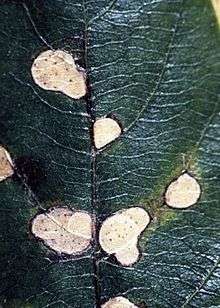Amphisphaeriaceae
The Amphisphaeriaceae are a family of fungi that is mainly found in parts of New Zealand, South America, Asia and parts of Europe. According to the 2007 Outline of Ascomycota, there are 41 genera placed within the family, although the position of 13 of those genera is uncertain.[1]
| Amphisphaeriaceae | |
|---|---|
.jpg) | |
| Pelotia fungi, a species of Amphisphaeriaceae | |
| Scientific classification | |
| Kingdom: | |
| Division: | |
| Class: | |
| Order: | |
| Family: | Amphisphaeriaceae G.Winter (1885) |
| Type genus | |
| Amphisphaeria Ces. & De Not. (1863) | |
Origins and controversies
This family of fungi was established as Amphispaerieae to contain the previously unclassified genera Caryospora, Strickeria, Ohleria, and Amphisphaeria, among others. However, the name was forgotten over time. In 1964, the name was reintroduced as the current Amphisphaeriaceae, and genera such as Apiorynchostoma, and again, Amphisphaeria. There was plenty of controversy about which order the Amphisphaeriaceae should be placed in. In 1973, Amphisphaeriaceae was placed under the order Sphaeriales (and some sources still classify it as such).In 1983, however, Amphisphaeriaceae was placed in under the order Amphisphaeriales, along with Cainiaceae, and Hyponectriaceae. After much study, however, Cainiaceae was merged with Amphisphaeriaceae, and were considered Xylariaceous. Because of this, Amphisphaeriaceae was officially placed in the order Xylariales in 1993.
Current status
Amphisphaeriaceae is a large, complicated family of Ascomycota. The asci are cylindrical or club-shaped, and they have a simple top ring that is amyloid (starchy), or sometimes nonamyloid. Many Amphisphaeriaceae genera have not been linked to anamorphs.

Many fungi that are part of the family are fatal to plants, causing them to die. In fact, several genera of Amphisphaeriaceae have been listed as invasive species.
Genera
A question mark before the genus name means the position of the taxon in this family is uncertain.
Amphisphaerella — Amphisphaeria — Arecophila — Blogiascospora — ?Broomella — Cannonia — ?Capsulospora — Ceriophora — ?Ceriospora — Chitonospora — ?Clypeophysalospora — Discostroma — Distorimula — Dyrithiopsis — ?Dyrithium — ?Ellurema — Flagellosphaeria — Frondispora — Funiliomyces — Griphosphaerioma — Iodosphaeria — Lanceispora — ?Leiosphaerella — ?Lepteutypa — Lindquistomyces — Manokwaria — Monochaetia — Monographella — Mukhakesa — Neobroomella — Neohypodiscus — Ommatomyces — ?Oxydothis — Paracainiella — ?Pemphidium — ?Pestalosphaeria — ?Reticulosphaeria — ?Urosporella — Urosporellopsis — Xylochora
Works cited
- https://web.archive.org/web/20120210055418/http://zipcodezoo.com/Key/Amphisphaeriaceae_Family.asp
- http://www.invasive.org/listview.cfm?list=4
- http://journals.cambridge.org/action/displayAbstract?fromPage=online&aid=42641
- http://www.fungaldiversity.org/fdp/sfdp/FD_1_147-157.pdf
- http://beta.uniprot.org/taxonomy/97129
- http://www.invasive.org/browse/family.cfm?id=902
References
- Lumbsch TH, Huhndorf SM. (December 2007). "Outline of Ascomycota – 2007". Myconet. Chicago, USA: The Field Museum, Department of Botany. 13: 1–58. Archived from the original on 2009-03-18.
| Wikispecies has information related to Amphisphaeriaceae |